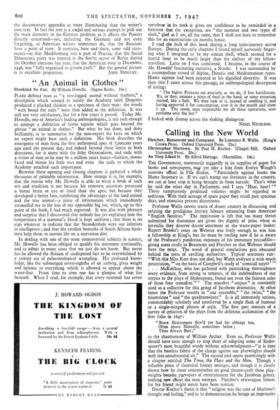" An Animal in Clothes 119
Mankind So Far. By William Howells. (Sigma Books. 16s.) PLATO defined man as " a two-legged animal without feathers," a description which seemed to satisfy the Academy until Diogenes produced a plucked chicken as a specimen of their man: the words " with broad flat nails " were then added to the definition. 'It was still not very satisfactory, but for a few years it passed. Today Mr. Howells, one of America's leading anthropologists, is not rash enough to attempt a definition of homo sapiens which goes beyond the phrase " an animal in clothes." But what he has done, and done brilliantly, is to summarise for the non-expert the facts on which an expert might base such a definition. His book describes the emergence of man from the first anthropoid apes of 7,000,000 years ago until the present day, and indeed beyond these limits in both directions, for it starts with the fishy Ostracoderm, and ends with a vision of man as he may be a million years hence—hairless, moon- faced and minus his little toes and even the nails to which the Academy attached such importance.
Between these opening and closing chapters is gathered a whole thesaurus of palatable information. How strange it is, for example, that the reason why Mr. Howells is able to write a book of such wit and erudition is not because his remotest ancestors possessed a better brain or eye or hand than the apes, but because they developed a better foot, combining the advantages of the land animal and the tree animal—a piece of information which immediately reconciled me to the loss of my opposable big toe, which, up to this point of the book, I had much regretted. It was also with pleasure and surprise that I discovered that nobody has yet explained how the temperature of a mammal's blood is kept uniform ; that there is no sign whatever to indicate that the Neanderthals were our inferiors in intelligence ; and that the swollen buttocks of South African bush- men help them to sustain life on a starvation diet.
In dealing with one of the most controversial subjects in science, Mr. Howells has been obliged to qualify his statement continually, and to admit in many cases that we just do not know. But never has he allowed the flotsam of undisputed fact to be overwhelmed by a stormy sea of palaeontological wrangling. His profound know- ledge, like the submerged seven-eighths of an iceberg, gives weight and balance to everything which is allowed to appear above the water-line. From time to time one has a glimpse of what lies beneath. When I read, for example, that every mammal has seven vertebrae in its neck it gives me confidence to be reminded in a footnote that the exceptions are " the manatee and two types of sloth," glad as I am, all the same, that I shall not have to remember this for an examination six months hence.
I read the bulk of this book during a long train-journey across Europe. During the early chapters I found myself nervously finger- ing what I imagined to be my simian shelf, which seemed for a horrid hour to be much larger than the shelves of my fellow- travellers. Later on I was comforted. I became, in the course of Mr. Howells' fascinating narrative, a Nordic. I was surrounded by a cosmopolitan crowd of Alpine, Dinaric and Mediterranean types. Homo sapiens had been restored to his dignified diversity. It was then that I came across this passage, an anthropological description of eating:
" The higher Primates eat precisely as we do, if less fastidiously. We, or they, ensnare a piece of food in the hand, or some extension thereof, like a fork. We then look at it, instead of smelling it, and having approved it for consumption, stow it in the mouth and chew it up. The snout, once responsible for all these operations, now performs only the last."
I looked with dismay across the shaking dining-car.
NIGEL NICOLSON.


































 Previous page
Previous page